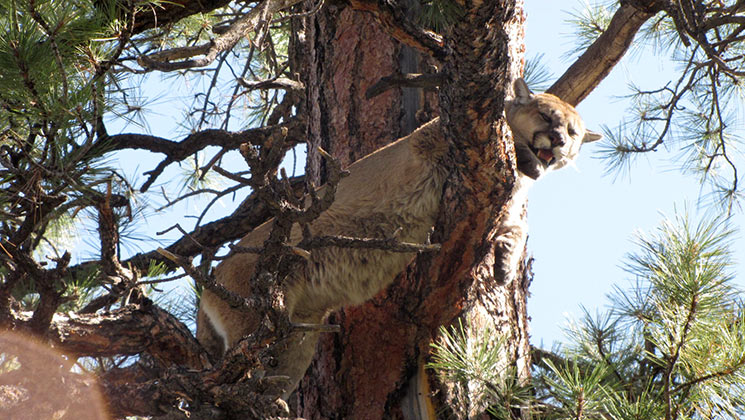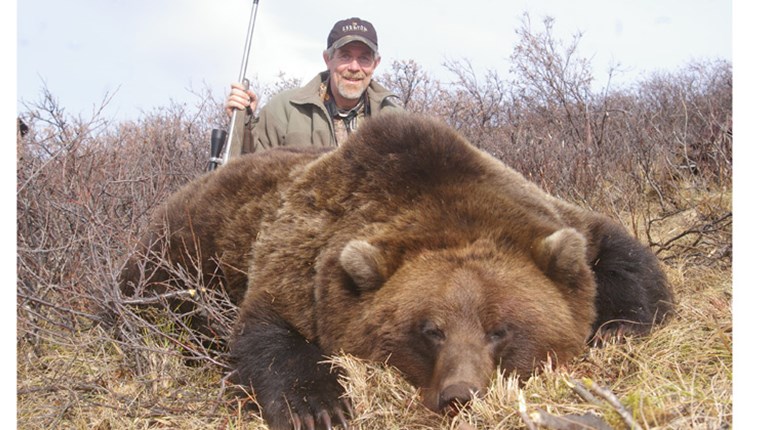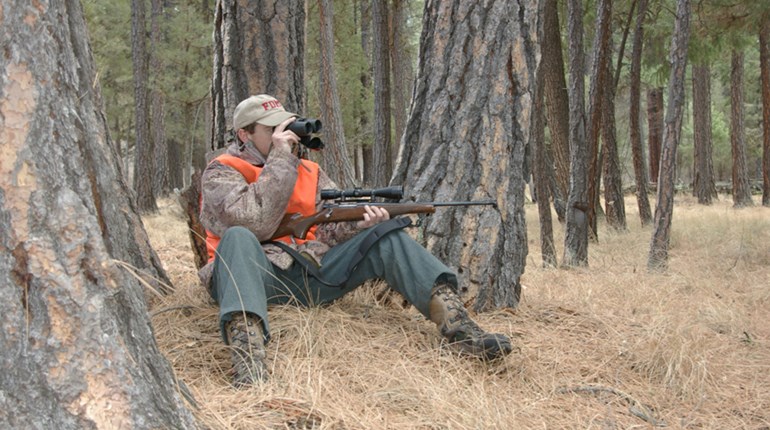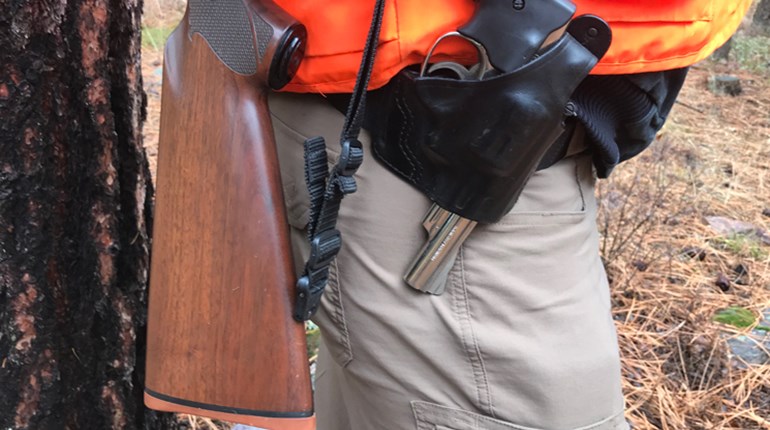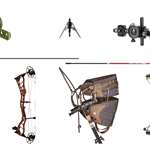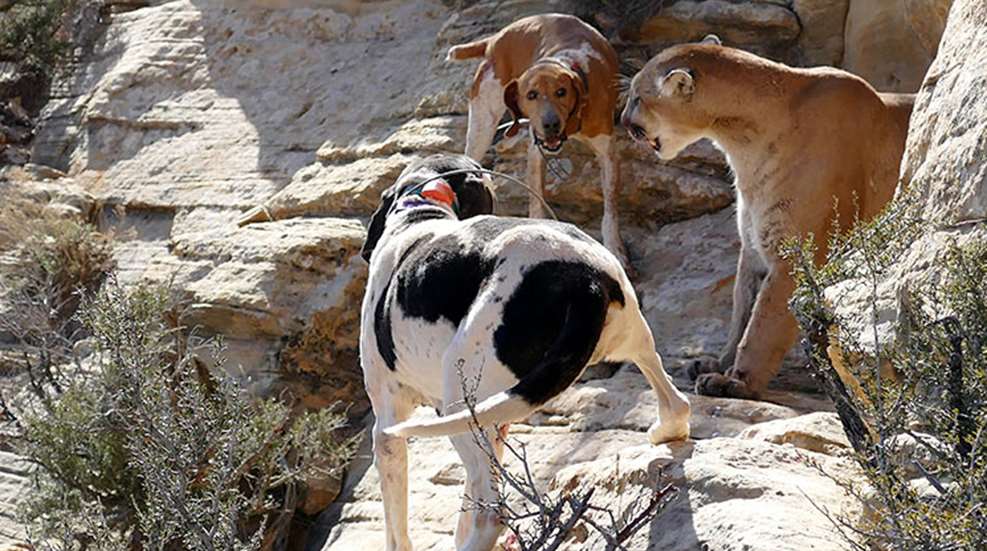
Three generations whose collective experience tracking and treeing mountain lions totals 140 years: that’s the Mecham family—patriarch Stan, his two sons, Clint and McLain, and grandson, Hunter. They live today where they have always lived, just east of and below the red, pinnacled rim of Bryce Canyon in the small Utah town of Tropic. All four are hunters and conservationists with a whole lot of cowboy tossed into the mix. This avocation and the passion with which they pursue it is the stuff of legends.
Stan Mecham just turned 80. He still saddles then loads his favorite horse, Skip, in the trailer, puts three or four of his hounds into kennels in the back of his pickup truck and heads into the vast landscape where he knows cats wait. He does this alone, that is, unless he’s helping Clint or McLain or Hunter with a client who has come to Utah to hunt. But mostly, the pleasure Stan takes these days from his solo outings lies mostly in the chase, in watching the hounds he breeds do what they’ve been trained to do. Very seldom does he take an animal when he’s on his own.
Stan smiles when he thinks back on his decision to learn how to track mountain lions. In his teens (circa 1950) he bought two hounds then tried for months to get his dogs to stay on a track. He failed to tree a lion that first year. He admitted to himself he didn’t know how to train dogs. Enter the legendary mountain lion hunter Jack Butler: Stan came across one of Butler’s hounds alongside the road and returned it to him, and as payback Butler shared with him lion-hunting techniques and his dog-training wisdom.
In the 60-plus years since, Stan has treed or cornered 900 mountain lions on the canyon ledges where big cats go when pursued.
“You can’t go after mountain lions without good dogs and a reliable mount,” he says. The hounds Stan raises and trains are much sought after and sell for thousands of dollars. In fact, this year he is being honored by the Utah Hound-Man Association as “Hound-Man of the Year.” His favorite hounds include the DNA of blue ticks, red ticks, Walkers, black-and-tans, and bloodhounds bred decades ago by Elmo Bushnell, Stan’s father-in-law. As a respected government hunter back in the 1940s, Bushnell was known for his hounds. The DNA of the dogs he used decades ago still courses through the veins of the hounds of the Mecham family.
Stan’s lessons learned from Jack Butler, his own experience treeing and cornering mountain lions plus his father-in-law’s knowledge: This is what Stan Mecham has bequeathed to his sons Clint and McClain, and now McLain’s son, 21-year-old Hunter.
Today, the latter generations take the pursuit to the next level.
Stan’s sons use their art of tracking big cats to conduct mountain lion and bear studies for the state of Utah. They use hounds to track and corner lions and bears then tranquilize them. Once tranquilized, a hood is placed over the animal’s head to keep it calm and to protect its eyes. Tissue and blood samples for DNA profiling are taken, body weight and measurements recorded, a dental exam is completed, sex is recorded and the overall health of the animal is noted. A tattoo (unique identifying mark) is placed in the ear of the tranquilized animal, and a GPS radio collar is fitted around its neck. The collar includes a tracking device and a radio transmitter. After all of this is accomplished, the dogs are taken away so they’re not around when the animal wakes up.
Working with the state since 1985, Clint is also predator specialist for Utah’s Department of Wildlife Resources. For this, he also depends upon his dogs. The data collected during the mountain lion studies Clint conducts helps Utah manage the cat population in the 29 units of the state. Many of these same studies also apply to other wildlife including bear, bighorn sheep, elk and deer.
Since he began doing these studies, Clint estimates he has collared 300 lions; because the batteries on the collars are good for only about a year, many of the lions he tracks he has collared several times. Of course, a chase often leads up a tree, Clint explains. From there, the cat will then catch its breath before coming down again. Then the chase resumes. This often happens a couple of times before the lion goes up a tree and stays put.
“These cats are very quick for a short distance,” says Clint, “but because they have small lungs they tire quickly and eventually after a couple of sprints they stay put on the boughs of a pine or aspen or up on a ledge.”
It’s at this point the dogs are tied back to protect them and the predator, for the dogs will climb trees to get to the cat. Instead, Clint climbs the tree to get to the cat. In the hundreds of times he has done this he has never fallen.
When he’s within 50 feet of the animal (the max range of his CO2-powered tranquilizer pistol) he aims it at a large muscle group. Hitting a large muscle is important—that’s where circulation is best, so the tranquilizer will quickly reach the brain. Clint won’t tranquilize a lion or bear if he can’t lower it safely to the ground. On occasion he has carried three, 30-foot sections of rope up a tree because the animal is situated so high.
About eight minutes after it’s darted, the lion begins to exhibit effects of the anesthesia. It will start to lick its lips. Its eyes begin shifting about as they try to focus. Then the eyes dilate. A leg may drop down over a bough as it crouches to maintain balance. At just the precise moment (this is where on-the-job training is so very important) Clint climbs up to the lion, slips the loop on the end of a 30-foot section of rope over the animal, wraps the rope around a branch to act as a friction brake then lowers it to the ground. If it’s winter, he tries to find a dry spot on which to lay the animal. If the animal’s stomach is full, he knows he’ll have about 45 minutes to lower it, climb down and collect all the data he needs—so he works quickly. With the radio collar attached to the animal, its location can be tracked by GPS satellite by the state.
Stan has six dogs, McLain and Hunter have 18 dogs, and Clint has 13 dogs.
The Mechams prefer dogs with “cold” noses. A cold-nose dog can pick up scent that is several days old and follow it, says McLain. This is especially important when a client comes in for a hunt that may last several days (more on this in a minute). They have bred their dogs for 60 years with this in mind; each litter comes into the world genetically inclined to a “cold nose.” When one of their lead dogs is put on the scent of a bear or a lion, it is programmed for the day. The only exception: When a fresher track is crossed the scent may confuse the dogs. “A good dog can determine when a cat is doubling back or circling around,” McLain says. “With a ‘cold nose,’ these hounds can track a lion for up to five days and still corner it.” When they’re on the track of a lion and the day ends, they return the next morning to the place where they stopped and the scent is picked up again.
But while all the Mechams agree a “cold-nose” dog is best, they still jokingly carry on a running dialogue about what makes the best lion dog. They also agree-and-disagree about what equine qualities make the best mount. McLain and Clint are “mule people” while Stan is a horseman.
Stan likes the Morgan breed. He says it is surefooted and never quits. However, the pony he rides today is a fox-trotter with a smooth gait and long stride. Stan claims his palomino, Skip, has three walking speeds before it breaks into a trot. “The endurance and surefootedness this horse exhibits when negotiating the canyons and badlands that stretch in every direction from my back yard is as good as any steed I’ve ever used when tracking lions or bears,” he testifies.
McLain, Clint and Hunter opt for mules. Mules typically have more endurance and can go longer distances without water, they say. Clint says his mules can go two days if they must. They will feed on the bark of a cedar tree, just like a goat. The hide on a mule is tough, which is important in this country where rocks, trees and brush can be tough on any skin. Mules are smart and don’t panic. If they fall they stop and won’t struggle to free themselves. “A mule will think through a situation where horses won’t,” Clint explains. “Furthermore, they can live to be 40 years old and still be productive.” Clint’s favorite mule is Ruby, one he traveled to Tennessee to buy and bring back to Tropic.
The Mecham men also disagreed on one other thing before the patriarch finally acceded. Years ago, in their lion and bear studies, Clint and McLain incorporated the digital age into their passion when on each dog they attached a Garmin GPS tracking collar. Before going digital, they had to stop and listen for the baying of the hounds to know where the dogs were and in what direction the hunters needed to go to get to them. Now they simply look at their handheld monitors to determine location and direction of travel. They can also tell by the data on the screen when a cat or bear has been treed or cornered. Stan now also uses these devices, though he admits he was “dragged kicking and screaming into the digital age.”
